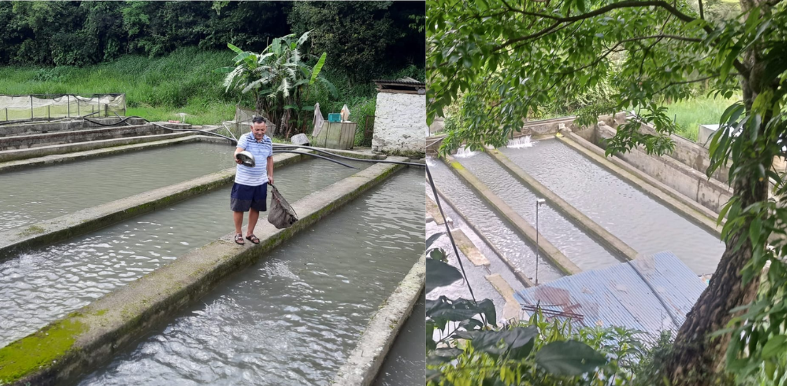Munish Sood
MANDI: Bollywood actor and Mandi Member of Parliament Kangana Ranaut visited the Kullvi Whims studio at Naggar in Kullu town of Himachal Pradesh and interacted with women artisans who are quietly reviving the traditional wool craft of Himachal Pradesh.
The studio, an intimate space filled with hand-spun yarns, looms and earthy fragrances of natural dyes, turned vibrant as Kangana sat down with the women to spin wool on a takli and observed their traditional methods of weaving and knitting.
Expressing deep admiration for their craft, Ranaut said, “These women are not just preserving our cultural legacy but are living embodiments of Himachal’s resilience and artistry. Every thread they spin carries the spirit of our mountains.”
She also purchased a few handcrafted items from the studio and encouraged the artisans to continue their pursuit of sustainable and meaningful livelihoods through traditional skills.
The visit came nearly a year after actor Sunny Deol also stopped by the same studio, appreciating the work being done to promote indigenous wool, natural dyes and hand-woven Himachal textiles. Over time, the quaint Naggar studio has quietly evolved into a creative hub that attracts visitors from across India and abroad — artists, designers and travellers seeking a genuine connection with the culture and craftsmanship of the Himalayas.
Brand woven from heart of mountains
Founded in 2012 by Nisha Subramaniam and Brighu Raj Acharya, Kullvi Whims stands for Women of Himachal Self-Help Group, representing a collective of traditional artisans from the Kullu Valley. But the name “Whims” goes beyond an acronym — it reflects the joy and individuality that each woman brings to her craft. Every woven or knitted piece bears a personal touch, an improvisation in pattern or motif born from the artisan’s own imagination.
The women associated with Kullvi Whims have inherited their skills — spinning, weaving, knitting, and crochet — through generations. Many once created woollen pattus, blankets, mojiris and socks solely for their homes and families. Today, under the Kullvi Whims banner, their work reaches global audiences while staying rooted in their traditional methods and seasonal rhythms of mountain life.
From shepherds to spinners – a complete local value chain
Kullvi Whims works in close collaboration with the Gaddis, the pastoral community of the Himalayas known for their nomadic lifestyle and centuries-old shepherding traditions. Every year, the Gaddis traverse hundreds of kilometers across high-altitude ranges, herding their flocks to lush summer pastures and back to the valleys in winter.
The indigenous wool sourced from these Gaddi shepherds is naturally dyed using local flora — wild madder, walnut husk, and pomegranate rind — to produce earthy shades that mirror the landscapes of Himachal. Each handwoven shawl or knitted sweater thus carries within it the story of its maker and the journey of the wool from mountain meadow to loom.
Through this holistic, locally rooted value chain — from shepherds to spinners, dyers to weavers — Kullvi Whims has built a model of sustainability, slow fashion, and community-driven enterprise. It challenges mass-production systems by valuing the time, creativity, and ecological balance embedded in every handmade piece.
Storytelling through design
Design at Kullvi Whims is not just about aesthetics but storytelling. Himachali craft traditions, whether woven or knitted, are known for their distinctive patterns and motifs. The Kullu and Kinnauri shawls, as well as the knit socks from Lahaul, are now protected under Geographical Indication (GI) tags for their unique identity.
At the studio, the process begins with conversations between the artisans and designers. Together they study old family weaves, forgotten motifs and traditional attire such as the pattu and dhordo. Through experimentation and reinterpretation, they create contemporary designs inspired by heritage, merging timeless skills with modern sensibilities.
Each product is a fusion of past and present — spun by hand, dyed naturally and crafted to reflect the rhythms of both nature and the artisan’s life. This creative freedom not only keeps intangible cultural heritage alive but also instills pride and economic independence among the women of the valley.
Minds behind the movement
Nisha Subramaniam, one of the founders, has spent over a decade working with women artisans and exploring the intersection of traditional craft and modern design. A visiting faculty at the Srishti Institute of Art, Design and Technology, Bengaluru, and CEPT University, Ahmedabad, she has dedicated her work to integrating craft into sustainable community development models.
Her co-founder, Brighu Raj Acharya, brings deep local insight through his background in eco-tourism as the founder of Himalayan Brothers Adventure. Having traversed remote villages across Himachal, he has documented local craft traditions and engaged youth in environmental and cultural conservation activities. His philosophy — of strengthening local economies through pride in local practices — lies at the heart of Kullvi Whims.





